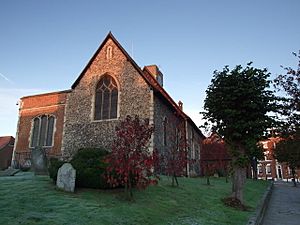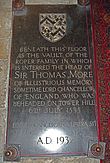St. Dunstan's, Canterbury facts for kids
St. Dunstan's Church is an old and important church in Canterbury, Kent, England. It is located where London Road and Whitstable Road meet. The church is named after Saint Dunstan, who lived from 909 to 988. This church gives its name to the part of the city on the left side of the River Stour.
The church building itself dates back to the 11th century, making it very old! It is a "grade I listed building," which means it's a very important historical site. The church was repaired and updated between 1878 and 1880. St. Dunstan's is a special place for many people because of its connections to famous historical figures like Thomas Becket and Thomas More.
Contents
History of St. Dunstan's
Who Was Saint Dunstan?
Saint Dunstan was a very important religious leader. He was the Archbishop of Canterbury from 960 to 978. After he died, he was made a saint. For a long time, he was the most popular saint in England. About 200 years later, Thomas Becket became even more famous. Saint Dunstan was buried in Canterbury Cathedral, but his tomb was later destroyed.
King Henry II and Thomas Becket
In 1174, King Henry II visited St. Dunstan's Church. He came to show he was sorry for the death of Archbishop Thomas Becket. At the church, King Henry II changed into simple, rough clothes. From St. Dunstan's, he began a walk to Thomas Becket's tomb at Canterbury Cathedral. This walk was a way for him to show his deep regret.
The Story of Saint Thomas More
Thomas More was a famous English lawyer and statesman. After his death, his brave daughter, Margaret, managed to get his head back from London Bridge. She brought it to her husband's family tomb, the Ropers, right here at St. Dunstan's. The Roper family lived very close to the church. Today, you can still see a small part of their old home called Roper Gate, marked with a special plaque.
The Roper family's burial place is under a part of the church called the Nicholas Chapel. This chapel is to the right of the church's main altar. The vault was sealed up a few years ago, following church traditions. A large stone slab on the floor marks where it is, right next to the chapel's altar.
The Nicholas Chapel has three beautiful stained glass windows. The window behind the altar shows important moments and symbols from the life of Saint Dunstan. Another window remembers a special visit on May 29, 1982. On that day, Pope John Paul II came to Canterbury to pray with the Anglican Archbishop of Canterbury. This visit happened at the place where Saint Thomas Becket was killed in Canterbury Cathedral. This window shows the symbols of both the Archbishop's church area and the Pope. There are also plaques on the walls that tell more about Saint Thomas More's story, including a prayer he wrote.
The Church Bells
St. Dunstan's Church has six bells. They are set up for a special way of ringing called "change ringing," which is popular in England. The heaviest bell weighs about 675 kilograms (around 1,488 pounds). The church's bell tower is quite narrow, so the bells are hung in two levels.
One of the bells is incredibly old. It is believed to have been made in 1325! This makes it one of the oldest Christian church bells in the world, nearly 700 years old today.
In 1935, the bells were taken out of the tower. This was done so that a strong concrete beam could be put into the tower to make it safer. While they were out, the bells were tuned by a famous bell-making company. They were then put back in the tower in 1936.
The bells are still rung regularly. The St. Dunstan's Society of Change Ringers practices on Friday evenings. They also ring the bells on Sunday mornings for the church service.



